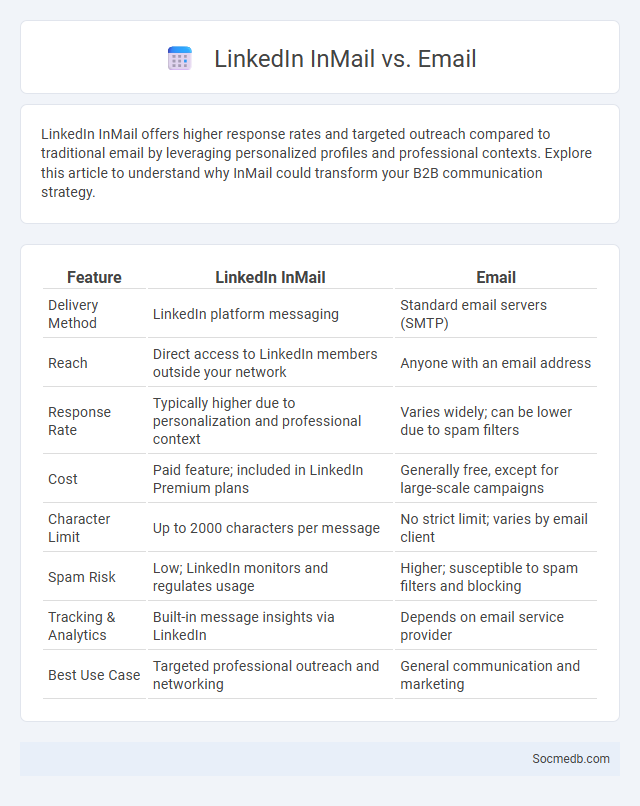
Photo illustration: LinkedIn InMail vs Email
LinkedIn InMail offers higher response rates and targeted outreach compared to traditional email by leveraging personalized profiles and professional contexts. Explore this article to understand why InMail could transform your B2B communication strategy.
Table of Comparison
| Feature | LinkedIn InMail | |
|---|---|---|
| Delivery Method | LinkedIn platform messaging | Standard email servers (SMTP) |
| Reach | Direct access to LinkedIn members outside your network | Anyone with an email address |
| Response Rate | Typically higher due to personalization and professional context | Varies widely; can be lower due to spam filters |
| Cost | Paid feature; included in LinkedIn Premium plans | Generally free, except for large-scale campaigns |
| Character Limit | Up to 2000 characters per message | No strict limit; varies by email client |
| Spam Risk | Low; LinkedIn monitors and regulates usage | Higher; susceptible to spam filters and blocking |
| Tracking & Analytics | Built-in message insights via LinkedIn | Depends on email service provider |
| Best Use Case | Targeted professional outreach and networking | General communication and marketing |
Understanding LinkedIn InMail: Features and Functionality
LinkedIn InMail enables direct messaging to professionals beyond immediate connections, enhancing outreach for recruiters and marketers. Key features include personalized message templates, read receipts, and response tracking, which optimize communication efficiency. Understanding InMail's functionality improves networking impact by targeting decision-makers with tailored content.
What Sets Traditional Email Apart from InMail?
Traditional email relies on direct access to a recipient's email address and functions through standard internet protocols, ensuring broad compatibility and control over message format and delivery. InMail, a feature exclusive to LinkedIn, allows you to send messages to users outside your immediate network but requires a premium subscription, offering enhanced targeting and engagement metrics. Your choice between the two should consider factors like audience reach, personalization, and platform integration to maximize communication effectiveness.
Key Differences: LinkedIn InMail vs. Email
LinkedIn InMail offers targeted communication directly within the LinkedIn platform, allowing you to reach professionals outside your network with personalized messages and higher response rates compared to traditional email. Unlike regular email, InMail bypasses spam filters and provides analytics on message delivery and engagement, optimizing your outreach strategy. Your choice between LinkedIn InMail and email should consider audience targeting, response tracking, and professional context relevance.
Pros and Cons of LinkedIn InMail
LinkedIn InMail offers targeted professional outreach, enabling users to connect directly with decision-makers outside their immediate network, resulting in higher response rates compared to regular messages. However, InMail can be costly for individual users and companies, and the unsolicited nature may sometimes lead to lower engagement or negative perceptions. Balancing the effective use of InMail with personalized messaging strategies is essential to maximize networking and business opportunities on LinkedIn.
Pros and Cons of Traditional Email Outreach
Traditional email outreach offers direct communication with a targeted audience, enabling personalized messages that can drive higher engagement and conversion rates. However, it faces challenges such as low open rates, risk of being marked as spam, and potential to appear intrusive, which can diminish effectiveness. Maintaining a clean email list and crafting relevant, value-driven content are crucial to optimizing outreach success.
When to Use LinkedIn InMail vs. Email
LinkedIn InMail is most effective for reaching out to professionals when you lack their direct email address or want to leverage the platform's networking features and profile insights. Use email for personalized, detailed communication when you have verified contact information or need to include attachments and formal correspondence. InMail messages typically have higher response rates for initial outreach within professional networks due to LinkedIn's trusted environment and targeting capabilities.
Response Rates: InMail vs. Email
Response rates on social media platforms differ significantly between InMail and traditional email, with InMail often achieving higher engagement due to its targeted approach on LinkedIn. InMail messages typically yield response rates around 20-30%, compared to 10-15% for cold emails, driven by personalization and professional context. Optimizing your outreach strategy by leveraging InMail can significantly improve Your chances of meaningful interactions and lead generation.
Cost Comparison: Email vs. InMail
Email marketing typically offers a lower cost per message compared to LinkedIn InMail, making it a more budget-friendly option for reaching a broad audience. InMail provides higher engagement rates due to its targeted approach but comes with a higher price point per contact. You should consider your budget and campaign goals when deciding between cost-effective email campaigns and the premium reach of InMail.
Best Practices for LinkedIn InMail and Email
Effective LinkedIn InMail and email campaigns rely on precise targeting and personalized messaging to boost response rates and engagement. Craft concise subject lines and open with a clear value proposition that speaks directly to Your recipient's professional needs and goals. Use A/B testing to optimize send times and message formats, ensuring Your communication resonates and drives meaningful connections.
Choosing the Right Outreach Tool for Your Goals
Selecting the right social media outreach tool depends on your specific goals, whether it's boosting engagement, increasing brand awareness, or driving conversions. Platforms like Hootsuite offer comprehensive scheduling and analytics, while tools like BuzzSumo excel in influencer identification and content research. Aligning your choice with your campaign objectives ensures efficient targeting and maximizes your ROI.
 socmedb.com
socmedb.com